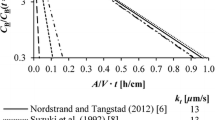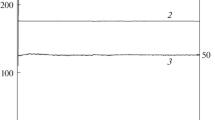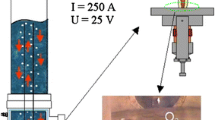Abstract
The volatilization of lead, copper, tin, and zinc from copper melts using the technique of top-blowing with an argon-hydrogen plasma jet was experimentally investigated and theoretically evaluated. A plasma burner with 16 kW power was used in the experiments. The mole flow of the plasma gases was 0.017 mol/s (25 liters/min when T = 25°C and PG = 1 bar). The temperature was 1830°C on the surface of the melt and between 1200 and 1500°C in the molten solution. When the zinc concentration is above 2 mole%, supersaturation of zinc occurs on the surface. In this range of concentrations the ratio of dilution of the concentration in relation to time is linear (zeroth-order reaction). When the concentration of zinc is below 2 mole%, the time dependence of volatilization can be described by an exponential law corresponding to a first-order reaction, because in this case the rate-determining step is the mass transport of zinc in the molten copper phase. From the change from zeroth-order to first-order reaction during the volatilization of zinc, the temperature on the surface of the melt can be estimated with a high degree of accuracy. On the other hand, the volatilization of tin and lead is determined by mass transfer in the gas phase, which leads to an exponential law for the whole range of concentrations. Reaction models were set up on the basis of the experimental data. The relationships thereby obtained permit one to evaluate in advance the yield of future industrial volatilization processes with top-blown plasma jets.
Similar content being viewed by others
Abbreviations
- A :
-
activity
- A e , m2 :
-
effective mass-transport or mass-transfer area
- k, mol/m2 s−1 :
-
mass-transfer coefficient
- k g , mol/m2 s−1 :
-
mass-transfer coefficient in the gas phase
- k s , mol/m2 s−1 :
-
mass-transfer coefficient in the melt phase
- k′, mol/m2 s−1 :
-
overall mass-transfer coefficient
- K =P i /x i :
-
equilibrium coefficient (distribution coefficient)
- K T =P i /a i :
-
equilibrium coefficient
- n s , mol:
-
number of moles of the melt phase
- n G , mol:
-
number of moles of the gas phase
- n g , mol/s:
-
mole flow of the top-blown gas
- n i , mol/s:
-
mole flow of the extract i into the gas phase
- P i , N/ M2 :
-
partial pressure of extract substance i in the gas phase
- t, s:
-
time
- T, °C or K:
-
temperature: Ts, in the melt; T∫, at the phase interface
- x i , mol/mol:
-
concentration in the melt
- X 1 f , mol/mol:
-
concentration in the melt at the phase interface
- w, s−1 :
-
rate constant
- y i , mol/mol:
-
concentration in the gas phase
- y i f , mol/mol:
-
concentration in the gas phase at interface
- z, m:
-
coordinate in the direction of mass transfer
- γ :
-
activity coefficient
- γ O :
-
Henry coefficient
References
H. Wilhelmi,Stahl Eisen 105, 1160–1166 (1985).
H. Schwall and H. Wilhelmi,Elektrowrm. Int. 45, 135–145 (1987).
O. Barin, Verdampfung und Verflüchtigung von Elementen aus einer Kupferschmelze durch Aufblasen von Argon-Wasserstoff-Plasmen, Dissertation RWTH, Aachen (1989).
W. G. Whitman,Chem. Met. Eng. 29, 147 (1923).
R. Higbie,Trans. Am. Inst. Chem. Eng. 31, 365 (1935).
H. L. Toor and J. M. Marchello,AIChE J. 1, 4 (1958).
M. K. Kishinevskij,Zh. Prikl. Khim. 24, 542 (1951);J. Appl. Chem. USSR 24, 593 (1957).
P. J. Spencer, A Thermodynamic Evaluation of the Cu-Zn System,Chalpat, Vol. 10 (1986), No. 2, pp. 175–185.
I. Barin,Thermochemical Data of Pure Substances, VCH, Weinheim (1989).
H. Lohe,Fortschrittber. V.D.I. Z., Reihe 3, Nr. 15, January 1967.
I. Barin and M. Modigell,Erzmetall 39, 618–623 (1986).
R. Hultgren, P. D. Desai, D. T. Hawkins, M. Gleiser, and K. K. Kelley,Selected Values of the Thermodynamic Properties of Binary Alloys, American Society for Metals, Metals Park, Ohio (1968).
J. M. Coulson and J. F. Richardson,Chemical Engineering, vol. 1,Fluid Flow, Heat and Mass Transfer, 3rd edn., Pergamon Press (1977), Chap. 8, pp. 268–307 and Chap. 10, pp.341–359.
Author information
Authors and Affiliations
Rights and permissions
About this article
Cite this article
Barin, O., Wilhelmi, H. & Barin, I. Mass transfer from copper melts by top-blowing of an argon-hydrogen plasma jet. Plasma Chem Plasma Process 11, 545–559 (1991). https://doi.org/10.1007/BF01447165
Received:
Accepted:
Issue Date:
DOI: https://doi.org/10.1007/BF01447165




